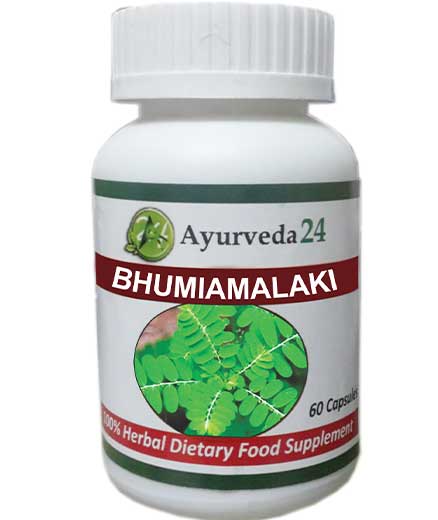Description
Botanical Name : Phyllanthus Niruri
Common Name: Country gooseberry, Bahupatra, Bhuiamla, Jaramla, Jangli Amala, Bhuianvalah
Since ancient times, Bhumi amla has been used as a medicinal plant. It is an annual herb which grows in the wild regions like Jharkhand, Bihar, Chhattisgarh, etc. states of India. However, it is also found commonly in coastal areas. Phyllanthus means “leaf and flower” because the flower and the fruit seem to be united with the leaf. It is a small erect annual herb that grows 40 -50 cm in height. So, it remains close to the ground or ‘Bhumi’. It resembles Amla in appearance. This gives the name “Bhumi amla”. Bhumi-amalaki is specifically quoted one of the best herbs for liver and kidney.
Classical Categorization
Charaka
Kasahara, Shwasahara(group herbs helping in cough/asthma)
Dhanwantri Nighantu
Chandanadi Varga
Bhavapraksha
Guduchyadi Varga(group of herbs which work on fevers)
Raja Nighantu
Papatadi Varga
Kaiyyadeva Nighantu
Oushadhi Varga
Energetics of Bhumi amalaki
According to Ayurveda
Rasa : Tikta (Bitter), Kashaya (Astringent), Madhur (Sweet)
Guna : Laghu (Light), Ruksha (Dry)
Virya : Shita (Cold)
Vipaka : Madhur (Sweet)
Effect on Tridosha : Kapha-pittashamak (alleviates Pitta and Kapha Dosha)
Useful parts: Entire plant
Chemical Composition
The main chemical content of the bhumi amalaki is lignans such as phyllanthine and hypophyllanthine. It also contains alkaloids and bioflavonoids such as quercetin. The seeds of the plant contain chemical compounds like Linoleic acid, Linolenic acid and Receinoleic acid. Its leaves contain Nirtetralin, Lignansniranthin, and phyltetralin chemical compounds. Fisetin-4-0-glucoside, a new Flavon glycoside has been detected from the aerial parts of this plant.
Medicinal Properties
- anti-viral & antibacterial
- hepatotonic, hepatoprotective & antihepatotoxic
- diuretic
- deobstruent
- carminative
- antimalarial
- anti-inflammatory
- vermifuge
- stomachic
- hypotensive
- antipyretic
- digestive & laxative
- antispasmodic
- antimutagenic
- antilithic
- analgesic
- hypoglycemic
- anticancer
- anti-diabetic
Benefits
Liver Disorders
It cures inflammation of the liver. It is used to treat Hepatitis A, Hepatitis B and Hepatitis C. Phyllanthus blocks DNA polymerase enzyme needed for the reproduction of the Hepatitis B and Hepatitis C virus and thus controls the progression. It helps in liver detoxification as well as nourishment as it has Rasayana (rejuvenating) and Pitta balancing properties. It is also used in the treatment of jaundice and other liver disorders. Along with kasni, it is used in the treatment of almost every liver and kidney disorders. So both of these herbs are called the best herbs for liver and kidney.
HIV Infection
Phyllanthus niruri inhibits the growth of the human immunodeficiency virus (HIV). Scientists hope that bhumi amalaki may be helpful in the treatment of AIDS.
Digestive Problems
It stimulates the liver and lights up the digestive fire. It also helps in constipation. It gives relief from dyspepsia, chronic dysentery, diarrhea, dropsy and many other issues.
Respiratory Disorders
It is useful for cough and asthma.
Diabetes
It has Tikta and Kshaya Rasa properties. It helps in improving metabolism and controlling blood sugar levels.
Heart Problems
It has Lipid lowering activity. It reduces the increased level of low-density lipoprotein lipids. Also regulates blood pressure and controls hypertension.
Female Health
It is used in the treatment of gonorrhea, menorrhagia (abnormally heavy bleeding at menstruation). It helps to relieve the symptoms of leucorrhoea.
Other Uses
- treats renal and gall bladder stones.
- Gives relief in ulcers, wounds, ringworms, scabies.
- useful in the treatment of genitourinary infections.
- Also used in itching and other skin diseases and oedema.
- Treat early stages of cataract, facial palsy and paralysis.
We will soon witness the day where Modern Medicine and Herbs (opposite fields of medicine) will work together for the Treatment and Benefit of the human.
CALL US FOR FREE CONSULTATION
WE PUT LIFE INTO LIFE

